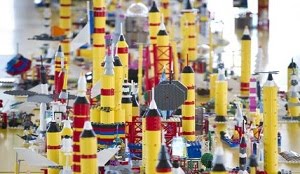
Heat, light and gravity, all necessary for life on Earth, pose serious problems for astronauts, a report in the Canadian Medical Association Journal says.
So does the rapid swing between day and night, radiation, vacuums, noise and dangers particular to the environment, such as space debris and buildup of electrical charges.
The potential issues, and precautions, are outlined in an article by Robert Thirsk of the Canadian Space Agency, Andre Kuipers of the European Space Agency Astronaut Corps, Chiaki Mukai of the Japan Aerospace Exploration Agency and David Williams from the department of surgery at McMaster University in Hamilton.
Canadian astronaut Robert Thirsk, top, with a Belgian and Russian colleague, about to board the Soyuz-FG rocket on May 27. Two days later, they docked at the International Space Station. (Anatoly Maltsev, pool/Associated Press)
All four authors are doctors who have spent time in space. Thirsk began a six-month stay at the International Space Station last week, where an important goal of the mission is to test the endurance of the human body in orbit.
The report outlines several potential effects of space on the body and highlights microgravity — weightlessness — as "the most profound aspect of the space environment on human physiology."
All organ systems are affected by weightlessness, and changes to the bodies of the crew will be monitored through tissue samples and various testing, the NASA website said.
From freezing to boiling
Heat and cold have to be managed carefully during spacewalks because temperatures swing from 100 C to –100 C as the International Space Station moves from being exposed to the sun to the shadow of the Earth, with a change every 45 minutes, the report said.
Spacesuits have active cooling while heating is "a passive process resulting from accumulated body heat." But there are also heaters in the astronauts' gloves, and thermal mittens can provide insulation from high temperatures.
With a transition from light to dark every 45 minutes — there are 16 daily sunsets and sunrises — astronauts face disrupted circadian rhythms, leading to poor sleep. Medications can help, but noise has proved to be a bigger sleep problem, the report said.
Fans, pumps and motors on the station produce noise similar to a normal conversation, but "inadvertent alarms have woken astronauts from sleep, an issue of particular concern if it occurs before a critical task on the mission."
Moreover, noise can affect communication between astronauts and might reduce concentration. To counter noise, the crew has hearing protection, and noisy equipment is muffled.
Radiation, which poses long-term risks of cataracts and cancer, is many times higher at the space station's orbit 350 kilometres above the Earth than at the surface of the planet.
Astronauts, exposed to galactic cosmic rays (particles from outside our solar system), particles trapped in the Earth’s Van Allen belts and solar flares, "are regarded as radiation workers and follow the 'as low as reasonably achievable' principles and guidelines, with radiation monitoring to document exposure," the report said.
Low and moderate doses of ionizing radiation can damage DNA, with the risk of damage being lower for older astronauts than for younger ones.
Spacewalking astronauts are also at risk of decompression sickness as they move from Earth-like pressure inside the station to the vacuum of space. To offset this, astronauts reduce the level of nitrogen in their system by breathing oxygen before a spacewalk. They're also trained to recognize the symptoms of decompression.
Physical dangers
The concern that micrometeoroids or orbital junk could hit the station or an astronaut on a spacewalk is countered by planning, armour and maneuvers.
Hitting even a small piece of material could be catastrophic.
"The impact of a collision of a one kilogram piece of space debris with the International Space Station has the same energy as a collision involving a 35,000-kg tractor-trailer travelling at 190 km/h," the report said.
But spacecraft are shielded, and the crew takes steps to avoid potential collisions. Also, spacewalks are scheduled to avoid known meteor showers, and space suits have a micrometeoroid shield.
The station can build up an electrical charge, which could arc to a spacewalking astronaut, but there is special equipment on the space station structure that is used to neutralize the charge.




0 comments:
Post a Comment